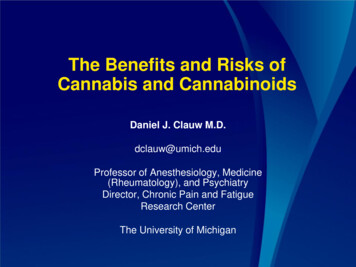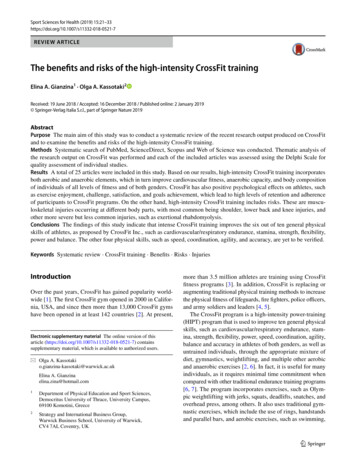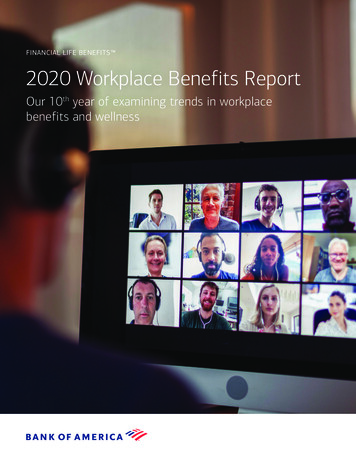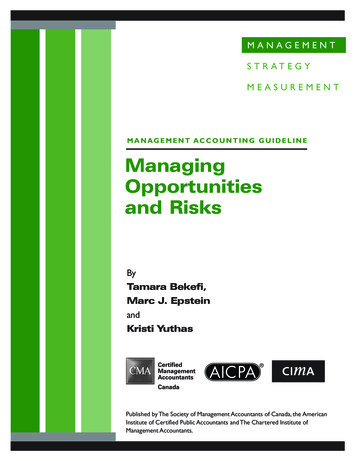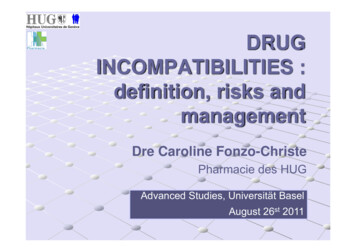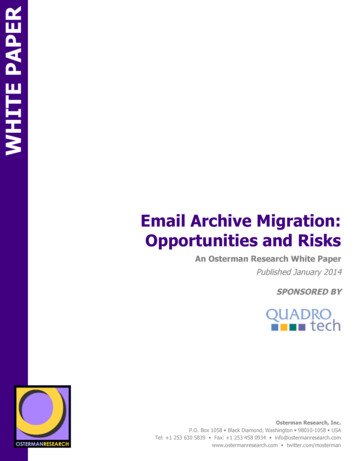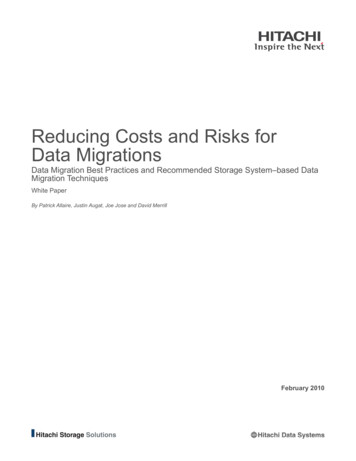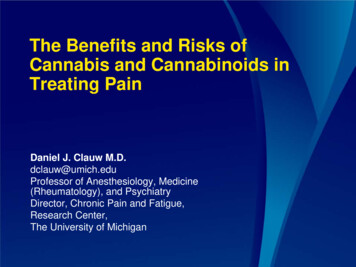
Transcription
The Benefits and Risks ofCannabis and Cannabinoids inTreating PainDaniel J. Clauw M.D.dclauw@umich.eduProfessor of Anesthesiology, Medicine(Rheumatology), and PsychiatryDirector, Chronic Pain and Fatigue,Research Center,The University of Michigan
Disclosures Consulting Research support Pfizer, Forest, Eli Lilly, Pierre Fabre, Cypress Biosciences, Wyeth,UCB, AstraZeneca, Merck, J & J, Nuvo, Jazz, Abbott, Cerephex, Iroko,Tonix, Theravance, IMC, Zynerba, Sammumed, AptinyxPfizer, Cypress Biosciences, Forest, Merck, Nuvo, CerephexOne-time licensing fee paid to University of Michigan byEli Lilly
How useful do you feelcannabinoids are for treating pain?0Worthless10Wonderful
Benefits and Risks of Cannabinoids Definitions and Background Benefits of Cannabinoids Risks of Cannabinoids Role in Treating Chronic Pain Summary
Benefits and Risks of Cannabinoids Definitions and Background Benefits of Cannabinoids Risks of Cannabinoids Role in Treating Chronic Pain Summary
Definitions Cannabis – A genus of flowering plants with three differentspecies: indica, sativa, and ruderalis Can be bred to have low amounts of psychoactive compounds (e.g.THC) that are used to make hemp, or high amounts that are used forrecreational/medicinal purposes Sativex is a oral spray that is a cannabis extractCannabinoid – Compounds that act at cannabinoid receptors Endocannabinoids – endogenous ligands produced naturally that bindto CB1 and CB2 receptors Phytocannabinoids – plant origin (cannabis/marijuana) At least 80 different cannabinoids in cannabisSynthetic cannabinoidsCB, cannabinoid receptor; THC, tetrahydrocannabinolPertwee RG. Handb Exp Pharmacol. 2005;(168):1-51.
Endocannabinoid system - IA set of receptors and their naturally occurringligands and enzymes regulating control Receptors – G-coupled protein receptors (the most abundant in CNS inman) on presynaptic membrane of cells in peripheral and central nervoussystem CB1 – Primarily in central nervous system (but not in medulla in man) these actprimarily to inhibit release of neurotransmitters CB2 – Largely found in periphery on immune and nerve cells (although some inCNS on microglia and DRG) Other receptors can bind these ligands because there is activity in CB1/CB2knockouts (TRPV1, GPR55)CB, cannabinoid receptor; CNS, central nervous system, DRG, dorsal root ganglionPertwee RG. Handb Exp Pharmacol. 2005;(168):1-51.
Endocannabinoid system - II Ligands – Endocannabinoids are eicosanoid lipidmessengers that are the physiological ligands for thecannabinoid receptors: ananamide (N-arachidonoylethanolamide, AEA) 2-arachidonoylglycerol (2-AG) PEA, virodamine, OAEEnzymes that synthesize and degrade the lipidsendocannabinoids, such as fatty acid amide hydroxylase ormonoacylglycerol lipase Drugs being developed for pain that inhibit these enzymesAEA, arachidonoylethanolamine PEA, palmitoylethanolamide; OAE, oleoylethanolaminePertwee RG. Handb Exp Pharmacol. 2005;(168):1-51.
Endocannabinoid system - IIISome known functions of the endocannabinoidsystem in humans: Memory – Generally affect short term memory, may play adaptive role inextinction of old memories in hippocampus Neurogenesis Appetite – Act in hypothalamus to increase appetite, inversely related toleptin levels Analgesia Immune function – Generally inhibit immune function, generally mediatedvia CB21 but some evidence CB1 might play role in T-cell responses. Maybe upregulation of CB2 receptors in some inflammatory disorders Stress – Help habituate/reduce HPA axis activity during repeated stress2CB, cannabinoid receptor; HPA, hypothalamic-pituitary-adrenal1. Rom S, Persidsky Y. J Neuroimmune Pharmacol. 2013; 8:608-20. 2. Hill MN, et al. Proc Natl Acad Sci U S A. 2010;107:9406-11.
CB, cannabinoid receptorImage source: Crowe S, et al. Brain Behav ImmunCrowe S, et al. Brain Behav Immun. 2014;42:1-5.
Cannabis-derived cannabinoidsMore than 80 known, with different strains havingdifferent relative concentrations THC (Synthetic forms include Dronabinol, Marinol, Nabilone) The primary psychoactive cannabinoid in cannabis, and itsmetabolites are those assayed for in drug tests Although it binds relatively equally to both the CB1 andCB2 receptors, most of its effects are associated with CB1activity in brainCB, cannabinoid receptor; THC, TetrahydrocannabinolPertwee RG. Handb Exp Pharmacol. 2005;(168):1-51.
Cannabis-derived cannabinoids Cannabidiol (CBD) Is not psychoactive and does not bind with any significant affinity to CBreceptors, but yet has anticonvulsant and anti-inflammatory effects Is actually thought to potentially protect against psychoactive effects ofTHC and hypothesized by some to be an effective anti-psychotic(although a recent Cochrane review concluded there was insufficientevidence of this) May act as a indirect antagonist of CB agonists – but it does not seemto reduce activity of THC Also acts as 5HT1a agonist which might be responsible for potentialanalgesic, antidepressant effects5HT1a, 5‐hydroxytriptamine 1A receptor; CB, cannabinoid receptor; THC, tetrahydrocannabinolPertwee RG. Handb Exp Pharmacol. 2005;(168):1-51.
Clinical Effects of Cannabidiol Best established effects are in epilepsy, especially rarechildhood forms such as Dravet Syndrome GW Pharmaceuticals is seeking approval of CBD for treatment ofDravet syndrome and was granted fast track approval Neuroprotective effects are also being aggressively studied Seems to be generally very well tolerated May lead to anxiety behaviors in animals although this is disputedCBD, cannabidiolWelty TE, et al. Epilepsy Curr. 2014;14:250-2.
Benefits and Risks of Cannabinoids Definitions and Background Benefits of Cannabinoids Risks of Cannabinoids Role in Treating Chronic Pain Summary
Potential Benefits of Cannabinoids Antiemetic1 – Marinol is FDA-approved (Schedule III) for use in postchemotherapy nausea/vomiting Anorexia – Marinol is FDA-approved for this use in AIDS-inducedanorexia in US Anti-spasticity agent2 Anticonvulsant3 – Focus on CBD effects Neuroprotective Being studied in Alzheimer’s4 because preclinical models show CB1/2activation leads to reduction in beta-amyloid Retrospective study of patients admitted with severe TBI showed significantreduction in death in those who had a positive drug screen for THC5Anti-tumor effects6AIDS, acquired immune deficiency syndrome; CB, cannabinoid receptor; CBD, cannabidiol; FDA, Food and Drug Administration; TBI, traumatic braininjury; THC, tetrahydrocannabinol1. Sharkey K, et al. Eur J Pharm. 2014; 722:134-46. 2. Koppel, et al. Neurology. 2014;82:1556-63. 3. Devinsky O. Epilepsia;2014:55:791-802.4. Aso E, et. al. Front Pharmacol. 2014;5:37. 5. Nguyen BN. Am Surg. 2014;80:979-83. 6. Cridge B, Rosengren RJ. Cancer Manag Res. 2013;5:301-13.
Anti-inflammatory effects of CBD There are many animal models where CBD has beendemonstrated to have potent anti-inflammatory effects in avariety of models (including murine collagen arthritis andcarrageenan models) but it is much less clear how thoseanti-inflammatory effects are being mediated Some evidence that anti-inflammatory effects might beoccurring via CB2 (very high doses needed), adenosinereceptors, arachidonic acid release (causes shift fromcyclooxygenase to lipoxygenase pathway), via directinhibition of cytokine production, or via binding to theGPR55 receptor (which has both inflammatory andnociceptive properties)CB, cannabinoid receptor; CBD, cannabidiol; GPR55, G protein-coupled receptor 55Burstein S. Bioorg Med Chem. 2015;23:1377-85.
Benefits and Risks of Cannabinoids Definitions and Background Benefits of Cannabinoids Risks of Cannabinoids Role in Treating Chronic Pain Summary
Risks of Cannabinoids Almost all available data is from long term recreational users so weprobably have good “worst case” data Partly related to route of administration Smoking cannabis may lead to chronic bronchitis and potentially cancer of themouth, throat, lung This is likely reduced or eliminated with use of vaporizers or e-cigarettes Oral administration causes less “likability” than inhalation or smoking andpresumably no risk of bronchitis or cancer Individuals using cannabis for medicinal purposes should probably be using anoral formulation but dosing is problematicThe few deaths associated with cannabis are generally due to severeparanoia or tachycardia associated with overdose via oral administrationDegenhardt L, Hall WD. CMAJ. 2008;178:1685-6.
Long Term Risks of Cannabinoids1 Psychotic illnesses It is now generally accepted that individuals who begin smoking cannabis priorto age 25 have 1.5 – 2.4X the rate of developing a psychotic illness2 This risk is modified by childhood trauma, family history of a psychotic illness,and perhaps genetic polymorphismsLong term effects on memory and brain structure Both neuropsychological testing, and functional and structural neuroimagingstudies, have suggested that individuals who use cannabis recreationallybeginning in adolescence have decreased cognitive performance1,3 These studies have significant methodological issues because of othercommon exposures (e.g. alcohol or other illicit drugs) and behavioral issues inthese individuals31. Hall W. Drug Test Analysis 2014:6:39-45 2. Radhakrishnan R. Front Pharmacol. 2014:5:1-6. 3. James A, et al. Psychiatry Res. 2013;214:181-9.3. Batalla A. PLOSone 2013;8:e55821.
Risks of Cannabinoids1 Respiratory Dependence Occurs in approximately 9% of individuals who use cannabis, but isabout double in those who begin using in adolescence This is lower than almost all other drugs of abuse (nicotine 32%,opioids 23%, alcohol 15%) Highest risk in those with poor academic achievement, deviantbehavior in childhood, poor parental relationships, family history ofsubstance abuse Physical addiction and withdrawal are much less common/severe thanother drugs of abuse1. Hall W. Drug Test Analysis 2014:6:39-45 2. Radhakrishnan R. Front Pharmacol. 2014:5:1-6. 3. James A, et al. Psychiatry Res. 2013;214:181-9.
Comparison of classification systems for the harms and risks of drug abuse in the developmentof the multi-category Nutt rational scaleCorrelation between mean scores from the independent experts and the specialist addictionpsychiatrists 1 heroin. 2 cocaine. 3 alcohol. 4 barbiturates. 5 amphetamine. 6 methadone.7 benzodiazepines. 8 solvents. 9 buprenorphine. 10 tobacco. 11 ecstasy. 12 cannabis. 13 LSD.14 steroidsNutt D, et al. Lancet. 2007 Mar 24;369(9566):1047-53.
Benefits and Risks of Cannabinoids Definitions and Background Benefits of Cannabinoids Risks of Cannabinoids Role in Treating Chronic Pain Summary
Role of Cannabinoids in TreatingChronic Pain Preclinical models Mechanisms of action Clinical trials in chronic pain states Underlying mechanisms of pain Efficacy Toxicity
Preclinical models of pain CB1 agonists, CB2 agonists and mixed CB1/CB2 agonistsare effective in a wide array of animal models of pain Because of CNS actions, compounds with prominent CB1activity cause more “off-target” side effects Selective CB2 agonists should have considerably less CNSeffects Good for nociceptive or inflammatory mechanisms of pain Not good for pain of CNS originCB, cannabinoid receptor; CBT, cannabidiol; CNS, central nervous systemPertwee RG. Int J Obes (Lond). 2006 Apr;30 Suppl 1:S13-8.
Role of Cannabinoids in TreatingChronic Pain Preclinical models Mechanisms of action Clinical trials in chronic pain states Underlying mechanisms of pain Efficacy Toxicity
Mechanisms of analgesic action ofcannabinoids In periphery, CB2 activation leads to fairly pronounced antiinflammatory effect May have less effect on nociceptive pain that is not of inflammatoryoriginIn CNS, cannabis (presumably mainly via CB1 effects) has adissociative effect of reducing connectivity between limbicand sensory brain regions and reduces the unpleasantnessof pain1 This is likely also the mechanism of action of cannabinoids for treatingnauseaCB, cannabinoid receptor; CNS, central nervous system1. Lee MC, et al. Pain. 2013;154:124-4.
Role of Cannabinoids in TreatingChronic Pain Preclinical models Mechanisms of action Clinical trials in chronic pain states Underlying mechanisms of pain Efficacy Toxicity
Mechanistic Characterization of PainVariable degrees of any mechanism cancontribute in any diseaseNociceptiveCauseInflammation ordamageNeuropathicCentralizedNerve damage or entrapmentCNS or systemic problemClinical features Pain is well localized,consistent effect ofactivity on painFollows distribution ofperipheral nerves (i.e.dermatome or stocking/glove),episodic, lancinating,numbness, tinglingPain is widespread andaccompanied by fatigue, sleep,memory and/or mood difficulties aswell as history of previous painelsewhere in bodyScreening toolsPainDETECTBody map or FM SurveyLocal treatments aimed atnerve (surgery, injections,topical) or CNS-acting drugsCNS-acting drugs, nonpharmacological therapiesTreatmentNSAIDs, injections,surgery, ? opioidsClassicexamplesOsteoarthritisDiabetic painful neuropathyAutoimmune disorders Post-herpetic neuralgiaCancer painSciatica, carpal tunnelsyndromeFibromyalgiaFunctional GI disordersTemporomandibular disorderTension headacheInterstitial cystitis, bladder painsyndromeCNS, central nervous system; FM, fibromyalgia; GI, gastrointestinalClauw DJ. The taxonomy of chronic pain: Moving towards more mechanistic classification. In: Wallace DJ & Clauw DJ, editors. Fibromyalgia and othercentral pain syndromes. Philadelphia: Lippincott, Williams & Wilkins; 2005. p.10-16.
Role of Cannabinoids in TreatingChronic Pain Preclinical models Mechanisms of action Clinical trials in chronic pain states Underlying mechanisms of pain Efficacy Toxicity
Cannabinoids for the Treatment of NonCancer Pain: A Systematic Review Cannabinoids studied included smoked cannabis, oromucosalextracts of cannabis based medicine, nabilone, dronabinol and anovel THC analogue Chronic non-cancer pain conditions included neuropathic pain,fibromyalgia, rheumatoid arthritis, and mixed chronic pain. Fifteen of the eighteen trials that met the inclusion criteriademonstrated a significant analgesic effect of cannabinoid ascompared with placebo and several reported significantimprovements in sleep There were no serious adverse effects. Adverse effects mostcommonly reported were generally well tolerated, mild tomoderate in severity and led to withdrawal from the studies in onlya few casesTHC, tetrahydrocannabinolLynch ME, et al. Br J Clin Pharmacol. 2011;72:735-44.
Benefits and Risks of Cannabinoids Definitions and Background Benefits of Cannabinoids Risks of Cannabinoids Role in Treating Chronic Pain Summary
Summary The endocannabinoid system is widely distributed in thehuman body and there is strong biological plausibility thatthese can be effective and safe analgesics at the right doseand in the right person Cannabinoids can exert analgesic effects in the periphery(mainly anti-inflammatory) and CNS (dissociate individualsfrom the sensory experience of pain) For treatment of clinical pain with cannabinoids there is bestevidence that they are effective in neuropathic andcentralized pain, and little current evidence that they areeffective in nociceptive/inflammatory pain statesCNS, central nervous system
Pragmatic Advice for UsingCannabinoids in 2017 Where possible use a cannabinoid or cannabinoid extract ofconsistent and known potency Start with CBD alone and then go to low dose of low THC:highCBD strain and go up slowly Emerging evidence of U-shaped curve Oral dosing better once stable dose and strain identified The strongest recommendation based on current benefit: riskdata is for the use of cannabinoids instead of opioids forneuropathic or centralized pain states Data from US suggest that legalizing cannabis in a state leads to fairly dramaticreductions in opioid overdoses1Use with caution in individuals under age 25CBD, cannabidiol; THC, tetrahydrocannabinol1. Bachhuber MA, et. al. JAMA Int Med 2014;174:1668-73.
Proposed marketing program for medicalcannabisCannabis plant talking to opiumproducing poppy plantWe don’tsuck asbad as youdo
How useful do you feelcannabinoids are for treating pain?010WorthlessWonderful
metabolites are those assayed for in drug tests Although it binds relatively equally to both the CB1 and CB2 receptors, most of its effects are associated with CB1 activity in brain. CB, cannabinoid receptor; THC, Tetrahydrocanna
